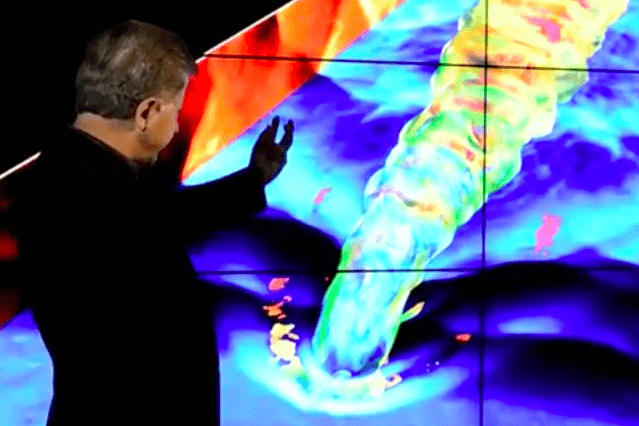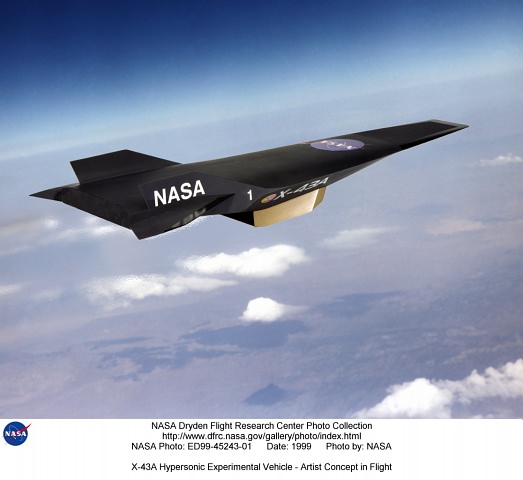Ever felt the need to get somewhere really, really quickly? Would Mach 17 work? That’s the speed a new prototype engine from researchers at the University of Central Florida (UCF) could potentially hurl an aircraft through the skies, making a trip from New York to Los Angeles in under half an hour. At the heart of this new technology is a new propulsion technology that stabilizes detonations and then uses their shockwaves to provide hypersonic propulsion to an aircraft.
cThe Awesome Complexity of Hypersonic Flight

Researchers at Stanford University are working on solutions to the inherent difficulties of hypersonic flight — speeds of over Mach 5, or 3,000 mph (4828 km/h) — and they’ve created one amazing computer model illustrating the dynamics of air temperature variations created at those intense speeds.
[/caption]
According to a news article from Stanford University, “Real-world laboratories can only go so far in reproducing such conditions, and test vehicles are rendered extraordinarily vulnerable. Of the U.S. government’s three most recent tests, two ended in vehicle failure.”
The video above shows some of the research team’s animation model — one of if not the largest engineering calculation ever created, it ran on 163,000 processors simultaneously and took 4 days to complete! And it’s utterly mesmerizing… not to mention invaluable to researchers.
“It’s something you could never have created unless you put computer scientists, mathematicians, mechanical engineers and aerospace engineers together in the same room,” said Juan Alonso, associate professor of aeronautics and astronautics at Stanford. “Do it, though, and you can produce some really magical results.”
In a (very tiny) nutshell, the behavior of air through an hypersonic engine — called a scramjet (for supersonic combustion ramjet) — changes at extremely high speeds. In order for aircraft to travel and maneuver reliably the scramjets have to be engineered to account for the way the air will respond.
“If you put too much fuel in the engine when you try to start it, you get a phenomenon called ‘thermal choking,’ where shock waves propagate back through the engine,” explained Parviz Moin, the Franklin P. and Caroline M. Johnson Professor in the School of Engineering. “Essentially, the engine doesn’t get enough oxygen and it dies. It’s like trying to light a match in a hurricane.”
“Understanding and being able to predict this phenomena has been one of the big challenges. It’s not one number or two numbers that come out of it at the end of the day… it is all of these structures that you see back there, the richness of it. It is understanding that allows you to control.”
– Parvis Moin, Stanford University professor
Thanks to this study, made possible by a 5-year $20 million grant from the U.S. Department of Energy, we may one day have aircraft that can travel up to 15 times the speed of sound. But the team’s groundbreaking computations aren’t just reserved for aeronautic aspirations.
“These same technologies can be used to quantify flow of air around wind farms, for example, or for complex global climate models,” said Alonso.
Read more on the Stanford University News here.
Video by Steve Fyffe and Linda Cicero. Source: Stanford University.
What is the Fastest Jet In The World?
If you’re thinking the X-15 still holds the record for the fastest jet in the world, think again. That title is now owned by NASA’s X-43A. The unmanned aircraft hit Mach 9.6 (nearly 10 times the speed of sound) on November 16, 2004 at an altitude of 33,223 meters over the Pacific Ocean.
Of course, if you’re talking about manned flights, the X-15 with its Mach 6.72 speed is still king of the hill.
Both the X-15 and the X-43A are experimental aircrafts, designed to test new technologies and are usually associated with record-breaking feats. The X-15, for example, was specially designed to reach altitudes and speeds never achieved before.
Pilots of these planes were considered astronauts since many X-15 flights exceeded 50-mile altitudes. Many of them practically reached what is known as the Karman line a.k.a. the ‘edge of space’. That’s about 100 km above sea level.
If you’re looking for an aircraft that’s actually been put to use outside gathering experimental data, then the record holder is the SR-71 “Blackbird”. The Blackbird used to cruise at Mach 3.2 and was used primarily for reconnaissance missions.
Anyway, back to the fastest jet in the world – whether manned or unmanned.
As mentioned earlier, the X-43A, like its reputable predecessor, the X-15, is an experimental aircraft. Specifically, the the X-43 was part of the NASA Hyper-X program, a 7-yr program that cost around $230M and was launched to explore other options for space access vehicles.
At the heart of the X-43 is the scramjet or Supersonic Combustion Ramjet. You can think of it as an upgraded version of the ramjet – the kind of engine used by the SR-71. The Supersonic Combustion Ramjet basically takes in oxygen, which is needed for combustion, directly from the atmosphere. In order to create thrust, rockets mix liquid oxygen with liquid fuel.
In the usual jet plane setup, a tank of liquid oxygen has to be carried as additional load. Take that tank away, and you get a smaller, lighter plane. The added benefits are so enormous that engineers who embarked on scramjet research predicted speeds that could go up to 15 times the speed of sound.
Although the current record held by the scramjet-powered X-43A only achieved a fraction of that, Mach 9.6 is still way above what other planes have achieved.
To give you an idea how fast the fastest jet in the world is, compared to others, imagine this: there are more than 30 jets that are faster than the speed of sound and yet almost all of them have top speeds either way below or only near Mach 3. Mach 9.6 is definitely way way faster than that.
We have some articles in Universe Today that are related to this one. Here are two of them:
- X-43 Receives Guinness World Record
- Speed of Light
Related articles brought to you by NASA, here are the links:
Tired eyes? Let your ears help you learn for a change. Here are some episodes from Astronomy Cast that just might suit your taste:
- Light Speed, Andromeda Galaxy, Dark Matter and Black Holes
- Running Out of Gravitons and Hitting the Brakes at Light Speed
Source: NASA


